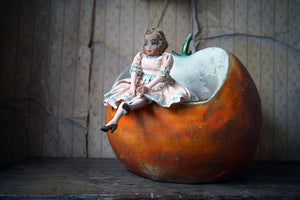Origin: English
Period: Late Victorian & Late 20thC
Provenance: Unknown
Date: c.1890-1990
Width: 16”
Height: 7”
Depth: 12”
The black leather covered mid-century traveling carry case with the pentacle logo inscribed to the top, opening to reveal another pentacle inscribed pine box along with a multitude of items associated with witchcraft, to include an array of glass bottles ranging in date from Victorian to late 20thC, a mini cauldron, more modern bottles labelled with terms such as frankincense, and silver arrows, some candles and mixing mortars, along with other paraphernalia as photographed; the wholes assimilation largely surviving from the latter part of the 20th century.
The compendium is in as found condition with the interior to the leather box torn and frayed and some damages to some bottles and phials. We have not attempted to clean, restore or repair any elements of the whole. The items are dirty and we have not tried to open any of the bottles.
When the Wiccan religion first came to public attention, its followers commonly called it "Witchcraft". Gerald Gardner—the man regarded as the "Father of Wicca"—referred to it as the "Craft of the Wise", "Witchcraft", and "the Witch-cult" during the 1950s. Gardner believed in the theory that persecuted witches had actually been followers of a surviving pagan religion, but this theory has now been proven wrong.
As a name for the religion, "Wicca" developed in Britain during the 1960s. It is not known who first used this name for the religion, although one possibility is that it might have been Gardner's rival Charles Cardell, who was calling it the "Craft of the Wiccens" by 1958. The first recorded use of the name "Wicca" was in 1962, and it had been popularised to the extent that several British practitioners founded a newsletter called The Wiccan in 1968. Many Wiccans believe in magic, a manipulative force exercised through the practice of "spellcraft". It has been suggested that Wiccans "identify with the witch because she is imagined as powerful - she can make people sleep for one hundred years, she can see the future, she can curse and kill as well as heal…and of course, she can turn people into frogs!"
The pentagram is a symbol rife with controversy in the Western world. Often portrayed as a symbolic representation of Satanism, it has historically been banned in schools, and only fairly recently was approved as a suitable symbol of religious affiliation for United States veteran’s headstones. Drawing a circle around the five points creates a similar symbol referred to as the pentacle, which is used widely by Wiccans and in paganism, or as a sign of life and connections.
Whoever who assembled this concoction was clearly committed to the movement and that makes it an honest and intriguing piece of occult related ware.
Period: Late Victorian & Late 20thC
Provenance: Unknown
Date: c.1890-1990
Width: 16”
Height: 7”
Depth: 12”
The black leather covered mid-century traveling carry case with the pentacle logo inscribed to the top, opening to reveal another pentacle inscribed pine box along with a multitude of items associated with witchcraft, to include an array of glass bottles ranging in date from Victorian to late 20thC, a mini cauldron, more modern bottles labelled with terms such as frankincense, and silver arrows, some candles and mixing mortars, along with other paraphernalia as photographed; the wholes assimilation largely surviving from the latter part of the 20th century.
The compendium is in as found condition with the interior to the leather box torn and frayed and some damages to some bottles and phials. We have not attempted to clean, restore or repair any elements of the whole. The items are dirty and we have not tried to open any of the bottles.
When the Wiccan religion first came to public attention, its followers commonly called it "Witchcraft". Gerald Gardner—the man regarded as the "Father of Wicca"—referred to it as the "Craft of the Wise", "Witchcraft", and "the Witch-cult" during the 1950s. Gardner believed in the theory that persecuted witches had actually been followers of a surviving pagan religion, but this theory has now been proven wrong.
As a name for the religion, "Wicca" developed in Britain during the 1960s. It is not known who first used this name for the religion, although one possibility is that it might have been Gardner's rival Charles Cardell, who was calling it the "Craft of the Wiccens" by 1958. The first recorded use of the name "Wicca" was in 1962, and it had been popularised to the extent that several British practitioners founded a newsletter called The Wiccan in 1968. Many Wiccans believe in magic, a manipulative force exercised through the practice of "spellcraft". It has been suggested that Wiccans "identify with the witch because she is imagined as powerful - she can make people sleep for one hundred years, she can see the future, she can curse and kill as well as heal…and of course, she can turn people into frogs!"
The pentagram is a symbol rife with controversy in the Western world. Often portrayed as a symbolic representation of Satanism, it has historically been banned in schools, and only fairly recently was approved as a suitable symbol of religious affiliation for United States veteran’s headstones. Drawing a circle around the five points creates a similar symbol referred to as the pentacle, which is used widely by Wiccans and in paganism, or as a sign of life and connections.
Whoever who assembled this concoction was clearly committed to the movement and that makes it an honest and intriguing piece of occult related ware.































